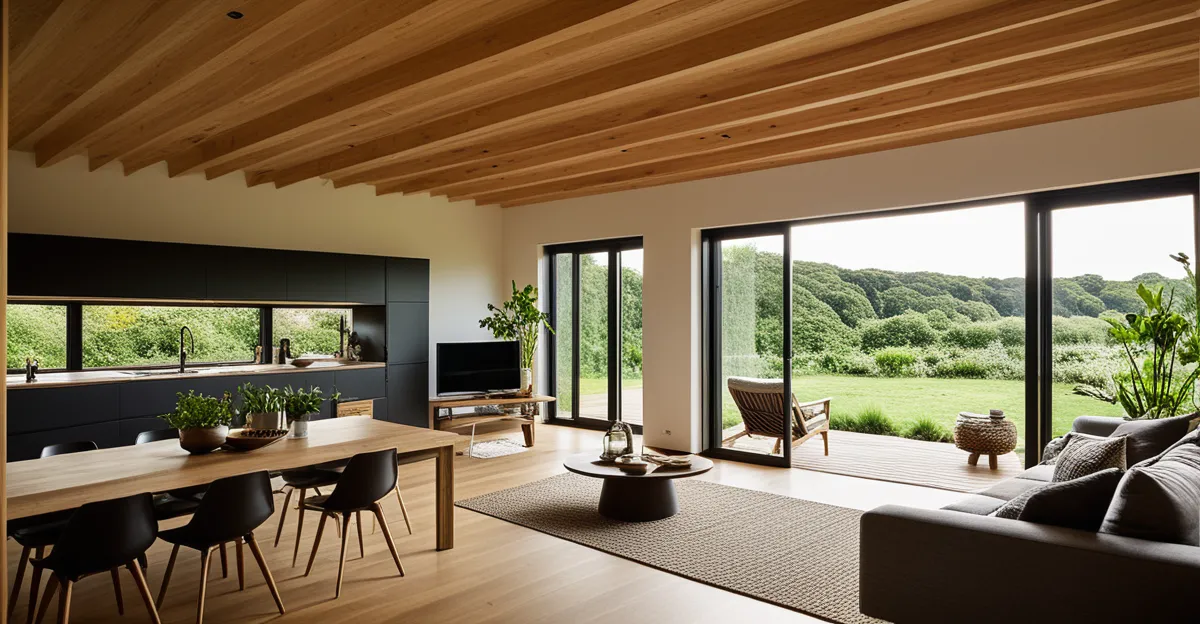Key Ways Sustainable Home Practices Transform Living Spaces
Sustainable home practices create living space benefits far beyond environmental impact. By focusing on areas such as energy use, material selection, and waste management, these practices enhance your home’s comfort, health, and overall value. For instance, using eco-friendly improvements like energy-efficient appliances and insulation boosts thermal regulation, making your home more comfortable year-round while reducing costly energy bills.
Material choices also play a crucial role. Incorporating sustainable home practices means selecting eco-friendly and recycled materials, which improve indoor air quality and offer durability. Natural, non-toxic materials help minimise exposure to pollutants, supporting better health for all occupants.
Additional reading : How Can You Reinvent Your Living Space to Enhance Comfort?
Another key advantage of sustainable living is waste reduction. By adopting recycling and composting strategies, homeowners promote significant resource conservation. This not only lessens landfill waste but also creates clutter-free environments that feel more spacious and well-organised.
Ultimately, these eco-conscious practices contribute to a healthier, more pleasant living space and can even increase property value by appealing to buyers who prioritise sustainability. By integrating sustainable home practices thoughtfully, you transform your living environment into a healthier, more cost-effective, and appealing space.
Also to read : How Can You Transform Your Living Space with Minimal Investment?
Increasing Energy Efficiency for Comfort and Savings
Energy efficiency is a cornerstone of sustainable home practices, directly improving both home comfort and reducing costs. Techniques like upgrading insulation, using smart thermostats, and installing energy-efficient appliances help maintain consistent indoor temperatures, eliminating cold drafts or overheating. This stable environment supports greater comfort year-round.
How exactly does improved energy efficiency reduce bills? By lowering the demand for heating and cooling systems, homes consume less electricity or fuel. Less consumption directly leads to noticeable cost savings, easing the financial burden of monthly utility bills while reducing your ecological footprint.
Moreover, energy-efficient homes often boast higher market value. Prospective buyers or renters increasingly prioritise sustainable features that promise lower energy expenses, comfort, and eco-friendliness. This alignment of energy efficiency with property appeal enhances your investment long-term.
Simple upgrades, such as sealing leaks around windows and doors or switching to LED lighting, offer quick entry points to improved efficiency. Incorporating programmable thermostats or smart home systems further optimise energy use by adjusting settings based on occupancy patterns.
Harnessing energy-saving methods is a powerful way to transform your home—boosting comfort, cutting costs, and increasing value through proven eco-friendly improvements.
Improving Indoor Air Quality and Health
Enhancing indoor air quality is a vital aspect of sustainable home practices that directly benefits health. Using low-VOC (volatile organic compounds) paints and non-toxic cleaning products reduces the presence of harmful chemicals in your living space. These eco-friendly improvements limit exposure to irritants and allergens, fostering a safer environment for everyone.
Proper ventilation plays a crucial role, too. Ensuring fresh air circulation via windows, exhaust fans, or mechanical systems helps dilute airborne pollutants. Introducing green plants can naturally purify the air by absorbing carbon dioxide and releasing oxygen, further supporting cleaner indoor environments.
Air purifiers equipped with HEPA filters capture fine particles such as dust, mold spores, and pet dander, significantly improving indoor air quality. Minimising synthetic chemicals and allergens also lessens respiratory irritations and allergy symptoms, contributing to overall health improvements for occupants.
By prioritising these strategies, homeowners embrace sustainable home practices that promote a comfortable, toxin-reduced space. This enhances well-being and aligns with broader goals of creating a healthier, more inviting living environment. These efforts demonstrate how attention to air quality is fundamental for long-lasting living space benefits.
Smart Use of Eco-Friendly and Recycled Materials
Selecting eco-friendly materials is central to sustainable home practices, shaping both the aesthetic and durability of your living space. Common eco-friendly choices include bamboo flooring, reclaimed wood, cork, and recycled metal. These materials reduce environmental impact by minimizing reliance on new resources and lowering waste.
Incorporating recycled materials into home décor adds character while supporting sustainability. For example, furniture made from repurposed wood or décor crafted from reclaimed glass offers unique designs and reduces landfill contributions. Using such materials aligns with sustainable decorating trends that favour longevity and environmental responsibility.
Beyond appearance, these choices enhance indoor environments by avoiding toxic chemicals often present in conventional building products. Eco-friendly materials also contribute to a healthier atmosphere by limiting off-gassing, improving overall air quality.
Durability is another key advantage. High-quality recycled or eco-conscious products often last longer, reducing the need for frequent replacements. This practical aspect complements the environmental benefits, making your sustainable home improvements cost-effective over time.
Ultimately, thoughtfully selecting materials promotes a harmonious balance between beauty, functionality, and ecological care—key living space benefits from adopting sustainable home practices.
Reducing Waste and Promoting Resource Conservation
Waste reduction is a fundamental pillar of sustainable home practices that greatly enhances living space benefits. How can you effectively minimise waste at home? The answer lies in combining conscious recycling with composting strategies. Recycling diverts common materials like paper, glass, and plastics from landfills, while composting organic kitchen scraps transforms waste into nutrient-rich soil. This reduces trash volume and actively supports resource conservation.
Beyond waste sorting, installing water-saving fixtures like low-flow faucets or dual-flush toilets cuts unnecessary water usage, conserving a vital resource within daily life. Adopting sustainable consumption habits—such as choosing products with minimal packaging or buying secondhand—complements these efforts by preventing excess waste at its source.
What practical benefits does this bring? Clutter-free, organised living areas emerge naturally as trash accumulates less, making spaces feel more open and calming. Additionally, the financial savings from reduced utility bills and lowered refuse disposal costs reinforce the appeal of these eco-friendly improvements.
In essence, embracing waste reduction and promoting resource conservation not only protects the environment but tangibly enhances your home’s comfort, cleanliness, and functionality—core advantages of sustainable living.

